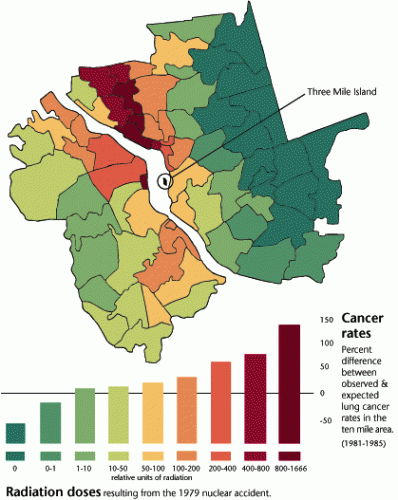Steve Wing reaches into a filing cabinet jammed full of paper and pulls out a letter written on stationery from the Pennsylvania House of Representatives. “Here, take a look at this,” he says. Leon Czikowsky, senior research analyst, writes that residents living around the Three Mile Island nuclear power plant have long suspected that radiation leakage has been causing cancer in people and their pets. And many women returning to the area for high school reunions report they’re infertile, but their doctors cannot find a reason for their sterility.
“Local residents report these findings,” Czikowsky writes. “I do not know if any of this information is useful to you or anyone you know, but I wish to pass it along.”
Experience, observations, impressions-this kind of evidence is usually dismissed by the scientific community as “anecdotal.” But Wing, an epidemiologist in the School of Public Health, believes such testimony can inform researchers in ways that the traditional scientific method cannot.
“It’s information I’d never have access to if I said, `I’m the researcher. Please don’t pollute my field with lay knowledge,’” Wing says.
Listening to the concerns of communities has thrust Wing into controversies that are usually the domain of politicians and lobbyists, not scientists. His recent work, a study of radiation effects near Three Mile Island and a project about the impact of the hog industry on eastern North Carolina, tackles the kinds of issues that provoke intense debate. But according to Wing, they are also health issues that demand scientific attention.
Responding to community concerns got Wing involved in his controversial Three Mile Island study. The nuclear power plant near Harrisburg, Pennsylvania, released radioactive gas in March 1979 after a series of mechanical failures led to a partial meltdown of the nuclear plant’s radioactive core. The molten uranium was contained inside the reactor building, and the overall radiation exposure to nearby residents was described as low-lower than most people receive from natural background sources. A 1990 study by a research group from Columbia University supported what nuclear operators and government officials had assured the plant’s neighbors-the accident posed no significant health threat.
Wing had no reason to doubt the Columbia group’s conclusions-until a few residents involved in a class-action suit against the power plant approached him describing symptoms consistent with radiation poisoning, including hair loss, vomiting, nausea, animal deaths, and unusual rates of cancers. Their concerns prompted Wing to take a closer look at the study.
The Columbia researchers had evaluated medical records from 19 area hospitals spanning the decade of the accident, 1975 to 1985. Among the 160,000 residents who lived within 10 miles of the plant, the scientists documented a 30 percent increase in lung cancer among people living downwind from the plant. But the researchers’ analysis found that the increase in the incidence of cancer did not deviate enough from the normal rate to be meaningful. They concluded the higher rate was probably due to other factors, such as smoking or stress.
Wing, along with coauthors David Richardson, Donna Armstrong, and Douglas Crawford-Brown, used the same data as the Columbia team but crunched the numbers differently. He and his colleagues arranged the medical records geographically, based on the residents’ proximity to the escaping radiation. They came across areas where residents’ lung cancer rates were four to six times higher than those living in other places around the plant. Where the original study found little to no increase in adult leukemia and a statistically unreliable increase in childhood cases, Wing concluded there were places downwind where residents were eight to 10 times more likely to develop the disease than were people in other areas. (see graph) And not only cancer rates, but also studies of plants, animals, and chromosomal damage in area residents suggested there might have been a greater release of radiation than officials had claimed.
Wing’s re-evaluation of the Columbia study has enraged some and delighted others. The Columbia group and nuclear officials have denounced his research, calling it “junk science,” “tendentious and unbalanced,” and “science done for litigation.” They maintain Wing’s research was biased because his funding came from the class-action plaintiffs’ attorneys through a nonprofit institute in Boston. Wing counters by reminding the Columbia group that their study was also prompted by litigation and funded by the TMI Public Health Fund, an account financed by insurers for the nuclear operators. The report also was reviewed and approved by attorneys for the industry before publication, Wing says.
But Wing believes their differences are as much methodological as they are ideological. He doesn’t accuse the Columbia researchers of fudging their data to make the findings more palatable to the nuclear industry. What troubles Wing instead is how quickly the concerns of the plant’s neighbors were dismissed. “This kind of antagonism of the scientific community toward acknowledging the experience of people is a problem,” he says. “I’m not saying you accept everything people say. People say lots of crazy things. People say they’ve seen Elvis or a UFO. What I’m saying is that it’s respectful to pay attention and ask questions and use the information of the witness.”
Wing argues that public health is as much about people as disease. And he believes that epidemiology-the study of how illness spreads-has become so consumed in recent years by the quest to understand the biology of disease that it’s neglecting people.
Epidemiology originated in biology. “Once germs could be isolated and seen in a microscope and even grown in a laboratory, people started completely focusing on the germ,” Wing says. But then medical researchers realized that infections were more complicated than germs alone. “For example, they realized that if they wanted to know about malaria,” Wing explains, “they had to know about mosquitoes, where they breed, and what environments are conducive to contact between mosquitoes and humans.” As a result, epidemiology became more ecological in its perspective.
But Wing says that modern epidemiology, like its germ-theory ancestor, pays too much attention to exposure and not enough to ecology. Some epidemiologists would argue that once the disease-causing agent has been identified, their work is over. But Wing disagrees. Identifying the exposure does not end disease. Although scientists identified the microorganism that causes cholera in 1883, for instance, epidemics continue. “In the case of cholera, we have more complex questions to address that deal with sewer services and clean water,” he says. “What we need to do now is figure out why people keep getting the disease. And that has to do with questions of the environment and society.”
Those questions-about people, their relationship to the environment, and the health of a community-are central to a project Wing is assisting in Tillery, North Carolina, a small, agricultural town in southeast Halifax County. With the county’s health department and the Concerned Citizens of Tillery (CCT), Wing is educating citizens about the environment, health, and the scientific process. And he’s helping the CCT assess the impact of the hog industry on eastern North Carolina, the first step in a quantitative study of environmental racism.
It’s important to understand the racial, social, and economic characteristics of communities with intensive hog operations, Wing says, because industries often locate in areas that lack local political power. The hog industry descended suddenly on eastern “black belt” counties-isolated, rural counties whose residents are generally poorer and less educated than elsewhere in the state. Between 1985 and 1992, the number of hogs in eastern North Carolina increased by 85 percent. In 1996, the state produced 13.3 million hogs-second only to Iowa.
Tillery is typical of communities that host intensive hog industries-poor and black. The CCT has assembled data to show that the populations of 12 of the top 15 hog-producing counties in North Carolina average 30 percent African American, whereas the state average is 20 percent. In 13 of those top hog-producing counties, the poverty rate among African Americans is 25 percent or more. In Halifax County, for instance, one-quarter of the total population and 40 percent of African Americans live in poverty.
According to Wing, the hog industry introduces environmental hazards into communities-odor, waste, and ground- and surface-water contamination. North Carolina’s hogs produce twice as much sewage as the state’s entire human population. Wing and the CCT want the community to understand these and other environmental hazards, including lead, agricultural chemicals, and soil erosion.
But Wing also wants citizens to become acquainted with the scientific process, to understand which kinds of questions are addressed by scientists and what scientific evidence can and cannot show. Science can help people understand why health problems occur, he says. And the results of scientific studies are often the artillery that community groups use to effect change. But community members can feel frustrated when their concerns aren’t supported by science. “Lots of times people think you just conduct a scientific study and you get an answer,” he says. “Sometimes they can be fairly clear. But often, studies are not definitive.”
Taking this community-based approach to public health, Wing cannot separate science from politics. Quoting mid-19th century physician Rudolph Vichow, he says, “Medicine is a social science, and politics nothing but medicine on a grand scale.” Debates about environmental racism, radiation effects, managed care, national health insurance-these are the obvious ways in which medicine is politics. “But politics is also medicine,” Wing says, “in the sense that public health gives us insights about how to prevent people from getting sick. Because once they’re sick, it’s too late. But to create the conditions in which people can stay healthy involves politics.”
Mary Dalrymple was a student who formerly contributed to Endeavors.
Research supported by the Center for Environmental Health Studies, John Snow Institute, and the National Institute for Environmental Health Sciences.




